Yo-EL Cassell’s Students Discover the J.O.Y. in Movement
His innovative technique helps young actors prepare for successful careers
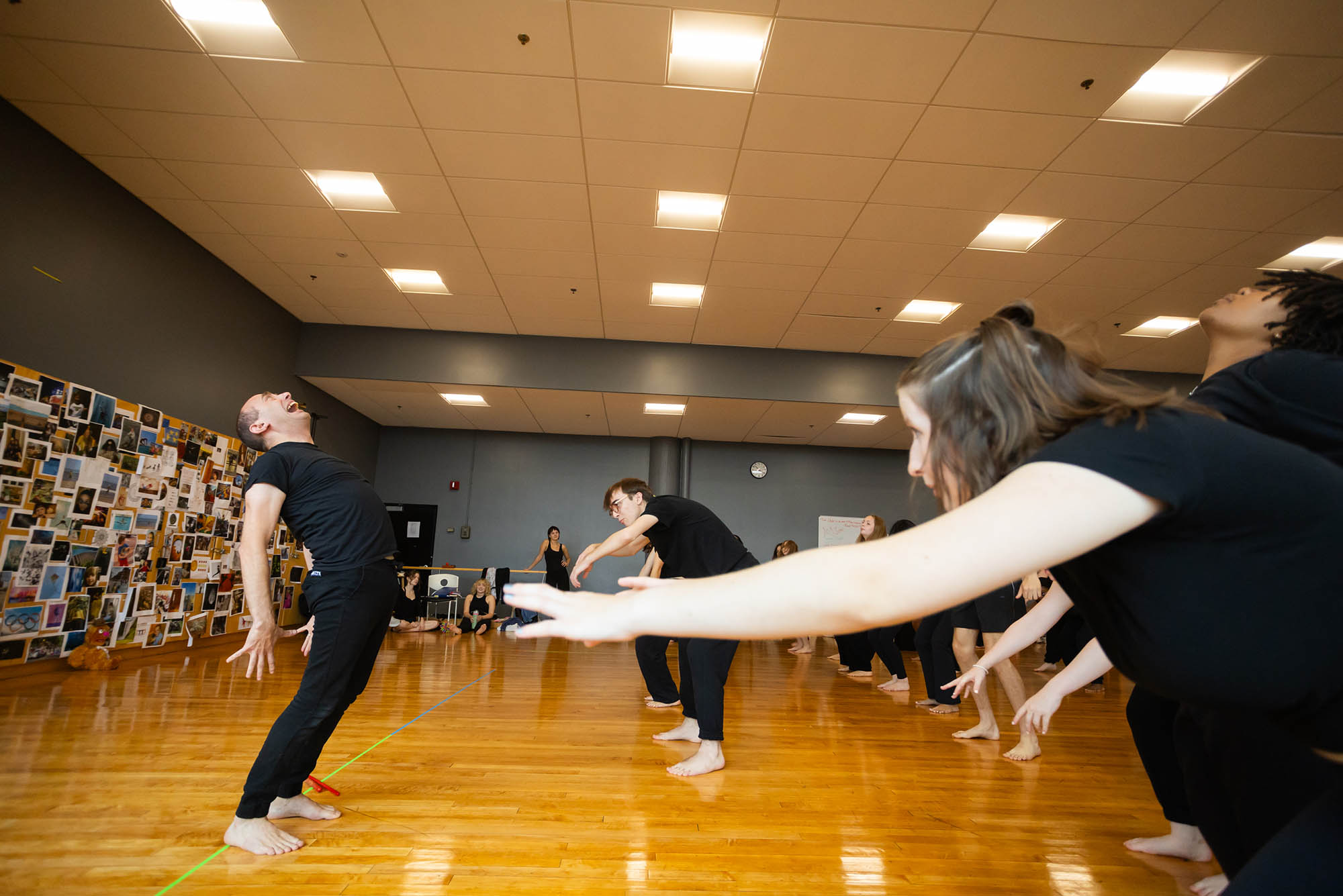
Yo-EL Cassell, a College of Fine Arts assistant professor of movement, often throws himself into demonstrating the exercises he wants his students to follow.
Yo-EL Cassell’s Students Discover the J.O.Y. in Movement
His innovative technique helps young actors prepare for successful careers
Crouched on a studio floor, about 50 first-year BU School of Theatre students don headphones or earbuds and cue up their favorite songs from childhood on their phones. Barefoot and dressed all in black, they rise to the music only they can hear and begin to skip and dance around the crowded room. Some sing along, eyes closed and heads tipped back. Others grin madly, faces red with exertion, hugging themselves or waving their hands in the air, a swirl of happy abandon.
Their teacher, Yo-EL Cassell, smiles at the chaos he has unleashed, but he also watches carefully, his eyes moving from face to face. He is hearing-impaired, so sight has an extra importance for him. “I want to see who is surrendering and who is thinking about it,” he quietly explains to a visitor.
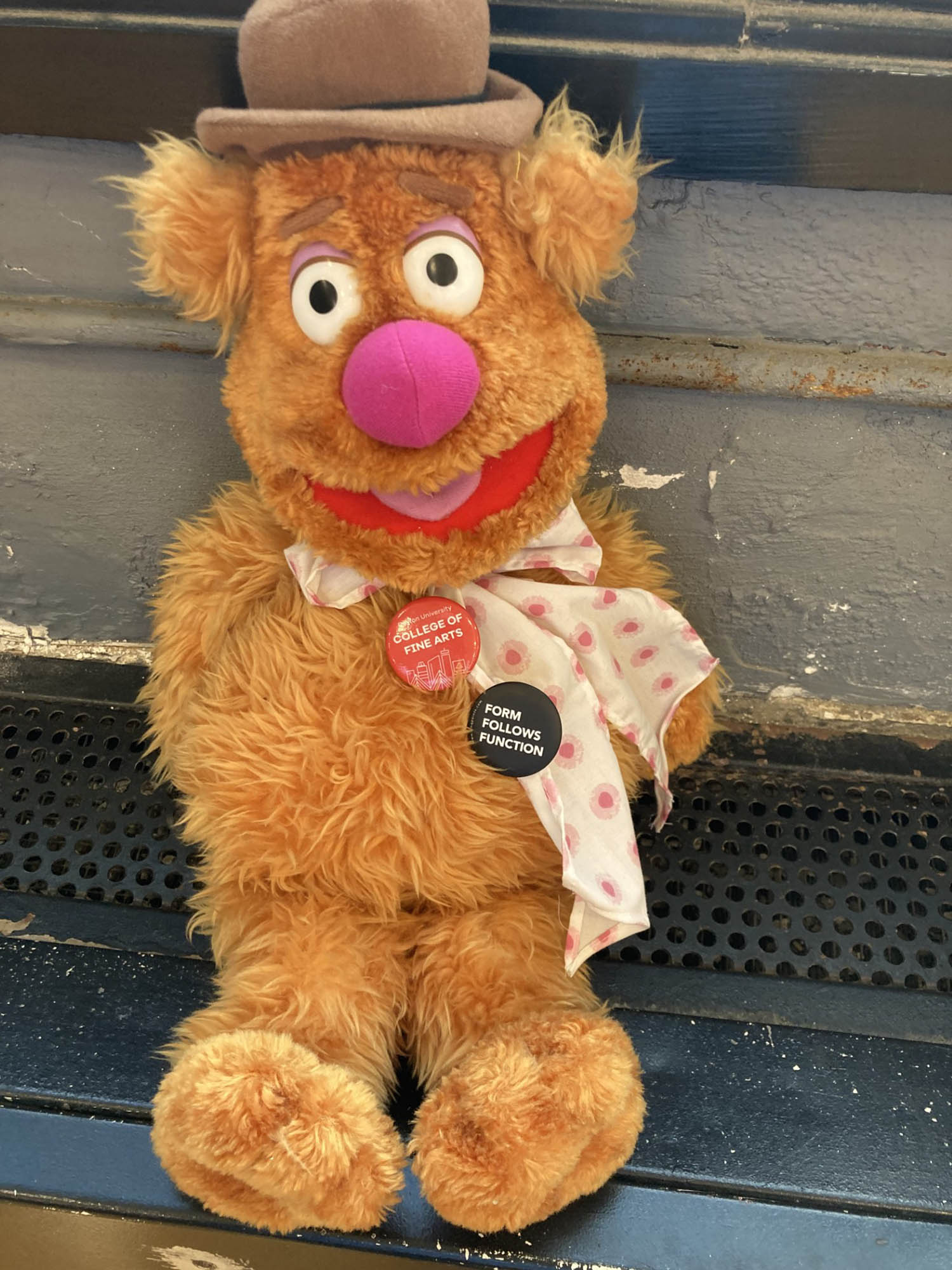
It’s just another September day in CFA TH 131: Movement 1: Expressive Human Instrument, taught by Cassell, a College of Fine Arts assistant professor of movement and School of Theatre head of movement. When the exercise is over, he waves around a stuffed Fozzie Bear, and students celebrate by shouting the orangish Muppet’s mantra, “Wocka! Wocka!”
Cassell urges his students to embody what he calls the J.O.Y. Technique. Not the traditional “joy,” but J.O.Y. as an acronym for Journey of Youth. Over decades, Cassell has created a method to get students to embrace curiosity and play as a child does. The class, a requirement for CFA’s performance core, uses movement as an expressive outlet for students’ inner landscape.
One exercise of many chosen at random from Cassell’s Breakfast Warm-Up Series is PUPPET/PUPPETEER: imagine you are a puppet being guided by a puppeteer—moving (gently tugging) each part of the body and the entire body in response to an imaginary initiation. Imagine the floor is a wall with holes with strings gently pulling and retreating. Another image is to think of your body on top of sand—leaving imprints of pattern as you explore.
To a casual observer, all the rolling around and waving limbs might look like touchy-feely silliness, but Cassell is a rigorous student of how the human body moves. His method takes into account anatomy, breath, heartbeat, fatigue, and accessibility issues. And the J.O.Y. Technique has begun to attract attention from movement educators around the country and beyond.
“It’s a toolbox,” Cassell says. “You’re likely to use one [exercise] from the first category and one from the next category and one from the fourth category. You’re not using them all every time. It depends on what the needs are in the room.”
His first-year students are less invested in the pedagogical theory than in the feeling.
“I’ve had a movement class before, but a lot of it focused on the form—tendus and pliés and that vibe,” says Caraline Casey (CFA’24). “When you focus on being a child and experiencing the world for the first time—instead of, ‘Oh, how do I look doing this pose? Are other people judging me?’—the form follows that. And you don’t have to think about it as much. And you breathe deeper.”
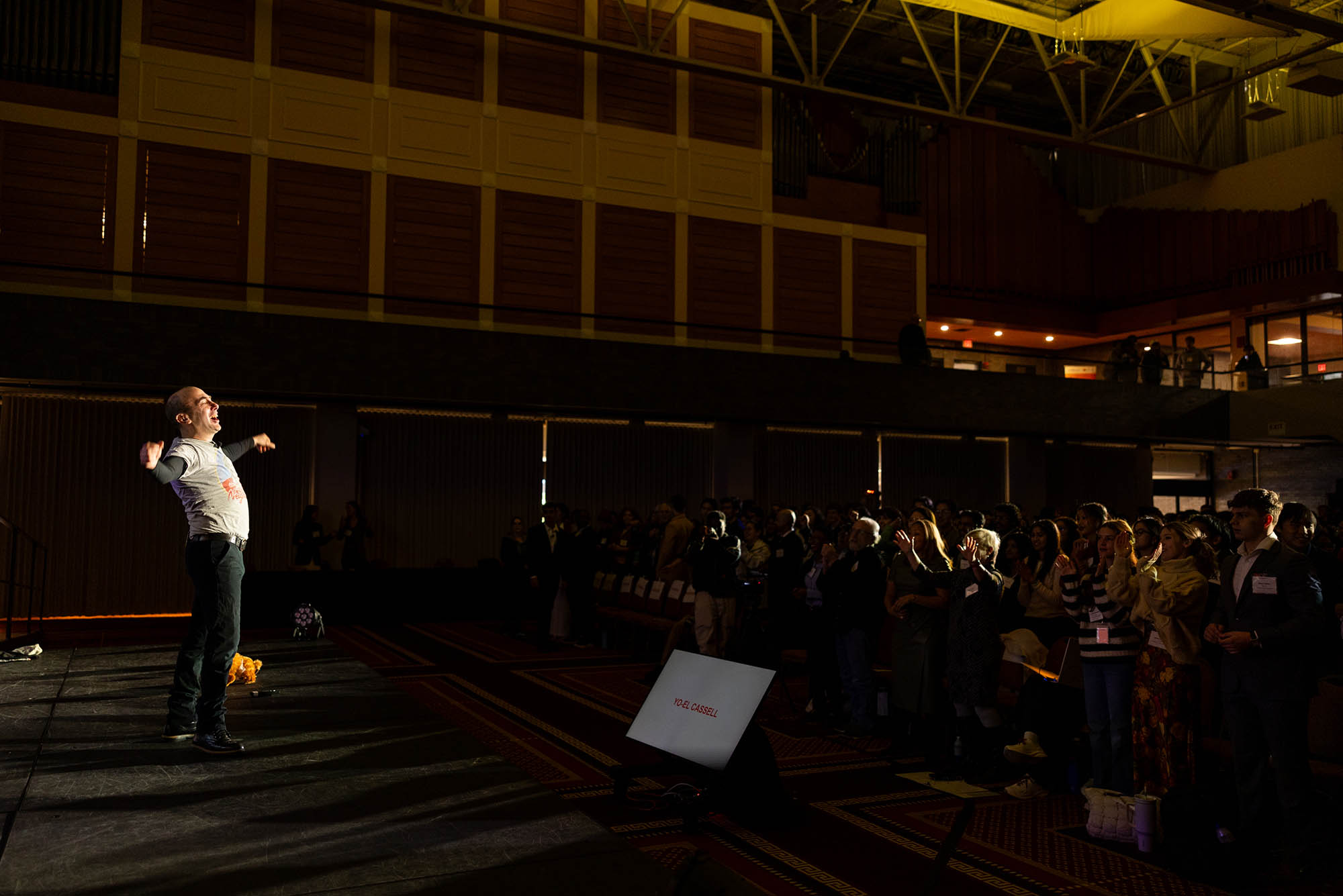
“When I had this class for the first time, I was like, what in the world is going on? I’ve never experienced anything like that,” says Scarlett McConnell Elder (CFA’24). “But his energy was so vibrant. Even if I had no clue what in the world this man was saying about cheesecake and random stuff, he believed in it. He’s always so happy to be there and his energy is so affecting.”
Fozzie was a Cassell childhood favorite that he remembered when he was looking for a mascot for the J.O.Y. Technique. Last month, he wocka-wocka-ed his way through clapping and movement exercises with a crowd of 400-plus student innovators from all over New England gathered at the George Sherman Union for Innovate@BU’s IdeaCON. He wanted to help them unlock their creativity, too.
Wearing a Mr. Rogers T-shirt, he repeated to the crowd a favorite Walt Disney quote: “Growing old is mandatory, but growing up is optional.”
One of a kind
The elfin, sunny Cassell often embodies that adage. In mid-sentence, he’ll start dancing around a room and high-kicking like Gene Kelly or crouch down and scowl like an ogre to illustrate a point. But another, less obvious, aspect of his presence also impacts his teaching.
Cassell uses hearing aids and sometimes in class, a closed-captioning interpreter. Primarily, though, he lip-reads, looking directly and intently at whoever is speaking. He knows that everyone who talks to him feels his attention concentrated on them.
“I often tell people that if I wasn’t hearing-impaired, I don’t know if I would truly be as invested in movement as I am,” he says. “But it means much more because of my hearing impairment, because of the sensations that I feel when I’m moving, the vibrations I feel, and the expressions that I am able to connect to visually and sensorially.”
Both his father and grandfather were also hearing-impaired. He attended a school for the deaf beginning at age three, and he remembers very clearly the dawn of his own expressive life. “We had a teacher who told us to roar like a lion”—naturally, he demonstrates, fists to his chest—“and boom! I felt alive. I was ecstatic.”
His mother was from Puerto Rico and loved to dance flamenco; his father was a native New Yorker and a tap dancer who worked in retail. The family went to lots of parties. “I remember feeling so alive, dancing and moving, and I would feel like I could hear and I could connect.” (Perhaps no surprise, either, that his older brother became a DJ, music producer, and promoter.)
Cassell’s résumé as a dancer, choreographer, and teacher includes everything from Ringo Starr’s Shining Time Station on PBS to the American Mime Theatre. In Boston alone he has worked with Commonwealth Shakespeare Company, Speakeasy Stage, Lyric Stage, Boston Landmarks Orchestra, and Boston Lyric Opera. He was program manager for Boston Ballet’s Citydance, providing free movement education to more than 3,000 public school children.
This summer he led a wocka-wocka workshop at the Association of Theatre Movement Educators conference in Atlanta, and he often hears from teachers around the country and beyond who have heard him expound on the J.O.Y. Technique.
Consider his schedule for his sabbatical next semester: he’ll present the technique in a January residency with internationally acclaimed movement director Ayse Tashkiran at Royal Central School of Speech and Drama in London. Then there’s a monthlong residency at the Accademia Dell’ Arte in Arezzo, Italy, where he’ll teach, perform, and finish up a second draft of his book proposal on the J.O.Y. Technique. From there, he’s off to Greece for a week presenting J.O.Y. to the International Theatre and Dance Project Intensive.
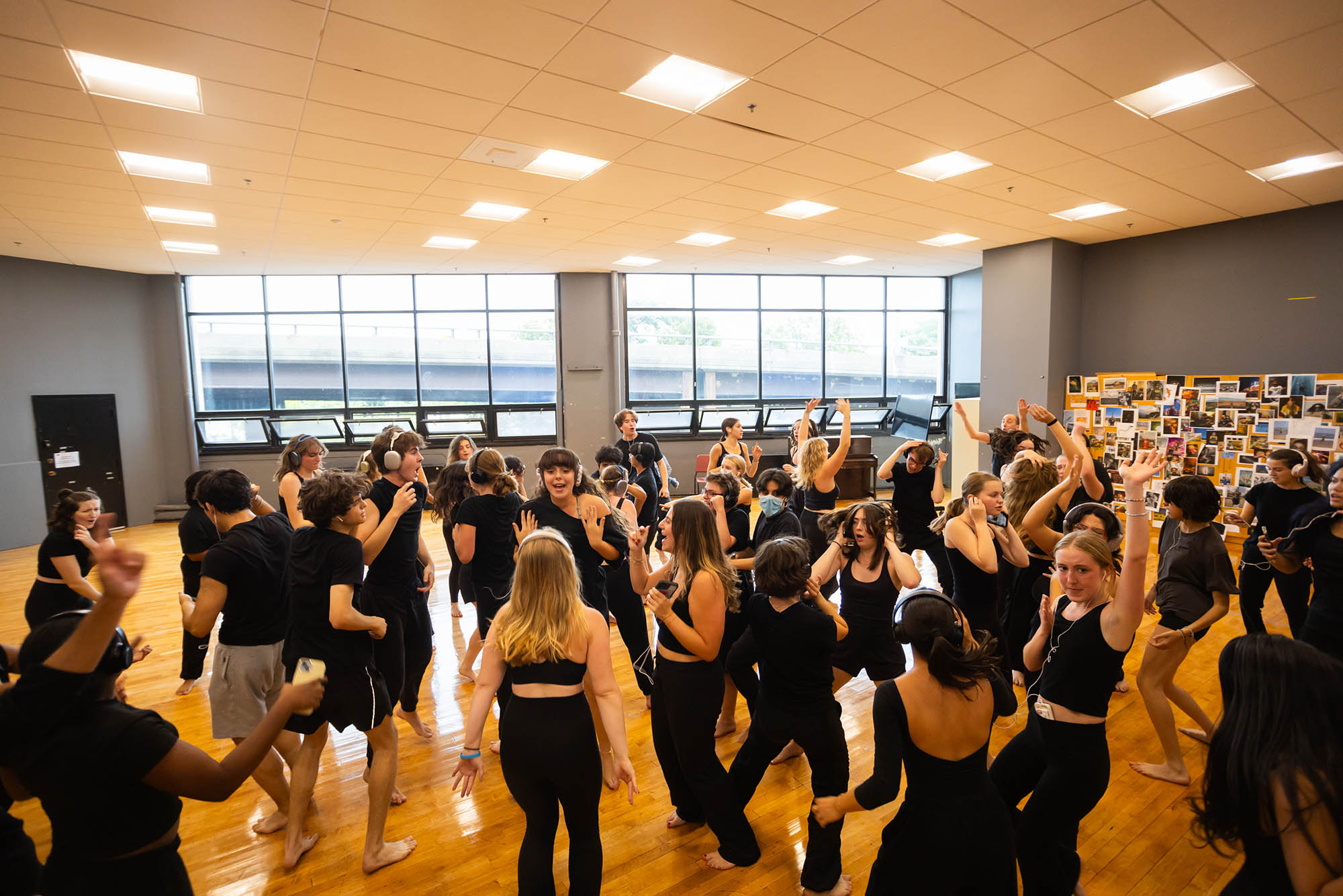
Amid all that, he’ll also be rehearsing an evening-length work cocreated with Mark Stanley, a CFA professor and head of lighting design and lighting designer for New York City Ballet, which will be presented in New York City later in the year. And Cassell is working on a partnership with American Physical Theatre as well.
“For me, it is about practicing what I preach to my students,” he says. “How I can embody my own Journey of Youth concept and be curious with where I am at this moment in time. Not try to recreate how I used to perform, but be curious about what it means to share my inner landscape publicly. Performing indeed reminds me that yes, I am alive, and that there is no grander feeling than finding space to move, to eventually move others.”
While he’s on sabbatical, one of his Movement 1 sections will be taken over by his wife, Melodie Jeffery-Cassell, a CFA lecturer. She’ll introduce a guest teacher who returns to their first-year classes every spring: their son Keaton, 10, who is named after the great silent movie physical comedian Buster Keaton and who is the embodiment of childhood curiosity and lower-case joy.
Career results
“Yo-EL’s attention to detail and his dedication to his students’ growth and understanding of how to dig deeply into their studio work and apply it to their rehearsal and performances is invaluable to our program,” says Kirsten Greenidge, director of the School of Theatre and a CFA associate professor of playwriting and theater arts, who is also an award-winning playwright. “He works incredibly hard, and I hope I am not revealing too much when I mention Yo-EL’s love of cheesecake and how his enthusiasm about all facets of this dessert speaks to his playful vibrancy.”
“I have ADHD, so I liked to move a lot growing up, and what Yo-EL is helping me do is channel that urge to move into a way that influences my art, right?” says John Burrell, Jr. (CFA’24). “I feel like that is all building up to where we’re going to put it into character work: how do they hold themselves? How do they do what they’re doing? I feel like taking it at the base level of just defining the elements and playing with your natural body as it is now is going to help you get to that place later on.”
Indeed, the playfulness lives on in Cassell’s classes for third-year students, but they are less about opening up and more about applying those techniques to drive their work.
“In year one, they’re learning the language and movement and they’re basically learning the language of energy,” Cassell says. “In year three, as they go through the trajectory of the movement curriculum, they learn about human nature, the inner animal, and begin to synthesize those energies to support form. And form becomes the character. We’re really learning about the spine, the character spine, not how they are on the surface, but what moves them, right? The inner life. Learning the language to activate that.
“But it happens through curiosity, not judging the character. As actors, we should never judge the character. The judging should come from the audience. We are curious and invested in: what moves the character? What makes them go fast? What makes them retreat? And so [students] can’t really understand that until they truly embody what that feels like. So they synthesize all of those energies to create characters.”
“Yo-EL is one of the most interesting characters I’ve ever encountered,” says Ashby Gentry (CFA’21), speaking from Calgary, where he’s filming the Netflix series My Life with the Walter Boys. (He stars as Alex, one of the Boys.)
Yo-EL is one of the most interesting characters I’ve ever encountered.
Like most CFA performance students, Gentry had four semesters of movement with Cassell, and he says he uses the techniques he learned from him every day.
“The character I’m playing, a lot of his story this year is about his transformation physically. He’s grown up,” Gentry says. “And every scene I’ve rehearsed, the starting point is always impulsive and it’s physical. It’s rooted in how I carry my chest and where and how does my weight sit in my body? Where does my breath sit in my body?
“You read the script and you’re struck with these gut impulses or insights into who this person is. And this year a lot of those are physical impulses. And my methodology for exploring those and the language I have to describe those—it all comes from Yo-EL.”
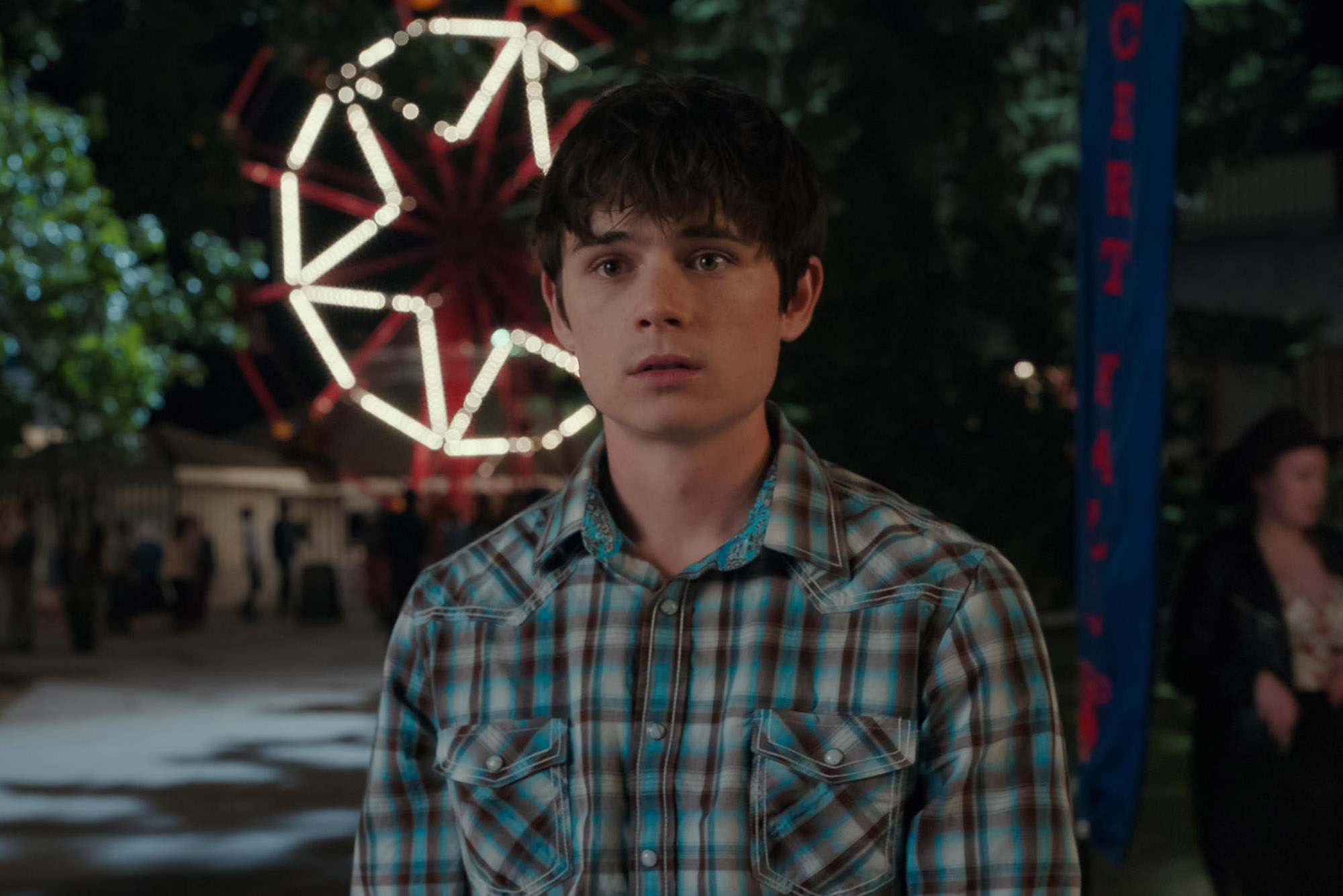
Like Gentry, Aidan Close (CFA’23) says he uses Cassell’s Morning Warmup Breakfast Series, offering a buffet of techniques and exercises, every working day. And it’s important, because the actor is playing eight shows a week as Scorpius Malfoy, one of the two leads in the national tour of Harry Potter and the Cursed Child. It can be grueling.
“The warm-up is a question,” Close says from Chicago, where he’s performing until February, when the show moves to Los Angeles. “I warm up and I feel like, where are the moments of tension, whether it be a specific body part or like, energetically. And then you activate the breath and then you activate the body and then you activate the spirit, and hopefully, by the time you walk on stage, your body is warm enough and also receptive enough to your own impulses.”
Underlying the J.O.Y. Technique is a certain feeling in the room when Cassell is teaching, an accepting, communal, noncompetitive spirit that allows the students to roll around and wocka-wocka without self-consciousness.
“I was really nervous my first semester of college, which I think a lot of people are,” Close says. “I put a lot of pressure on myself, and I was burned out because I was so eager to prove myself. And Yo-EL’s classroom was a haven from that ambition.”
During COVID, he says, when we all lived on our phones and through Zoom, Cassell’s class was especially important: “We were kind of like floating heads, experiencing the world through our screens and coming up with very cerebral thoughts, but our grounded feet and our breath have a lot to say.”
Close thrived in Cassell’s classes, with their emphasis on play and on joy and on your body being the solution, he says. “There was a dissonance in me, where I would see my current skill level and I would see where I wanted to be, and there’s a mile between them. And he would be, like, this is where you are. And the answers are inside of you. And you are enough.”
Comments & Discussion
Boston University moderates comments to facilitate an informed, substantive, civil conversation. Abusive, profane, self-promotional, misleading, incoherent or off-topic comments will be rejected. Moderators are staffed during regular business hours (EST) and can only accept comments written in English. Statistics or facts must include a citation or a link to the citation.